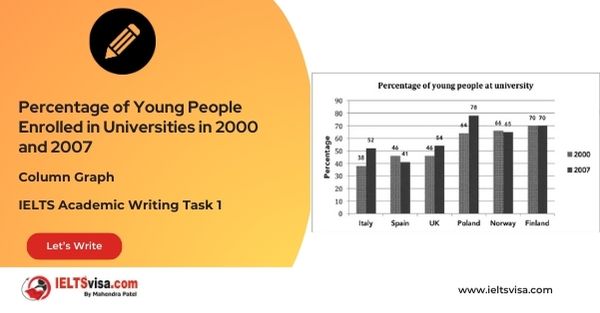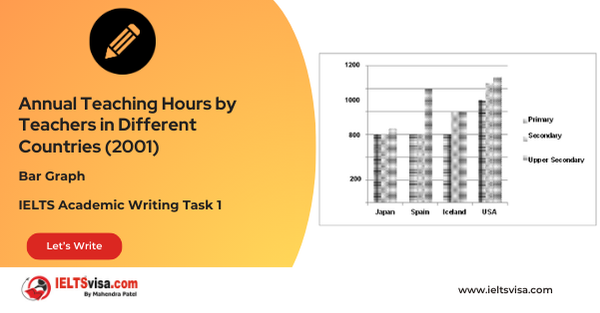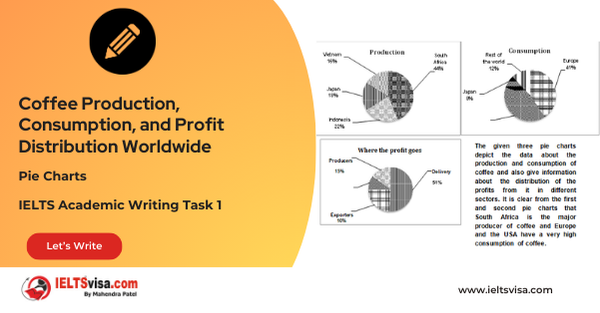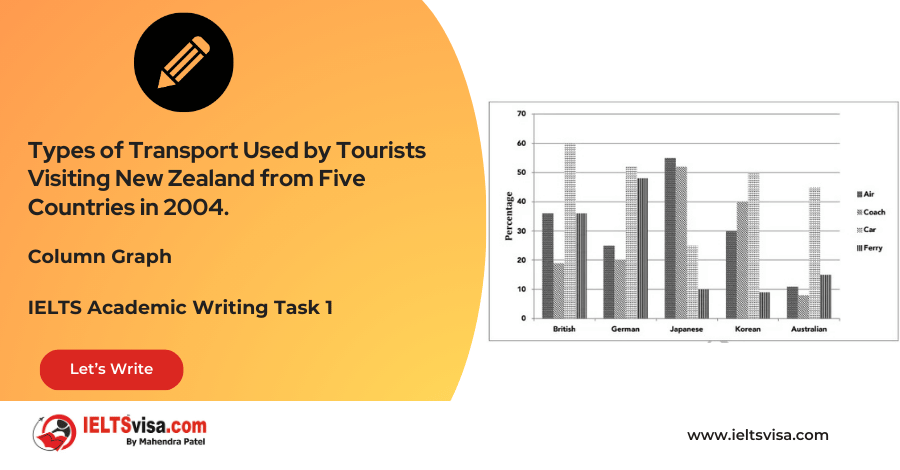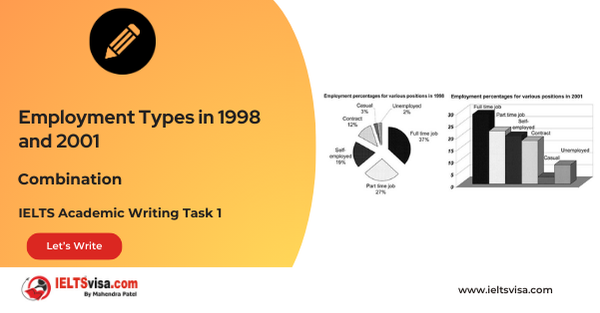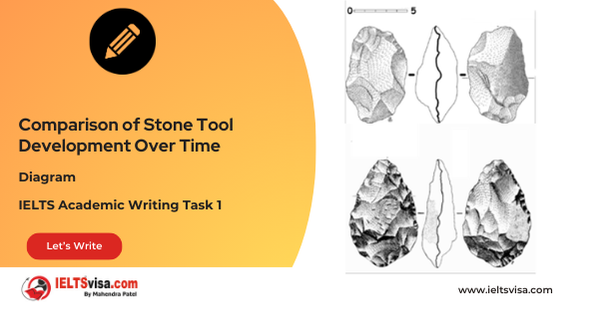The production of milk annually in four countries in 1990, 2000 and 2010
IELTS Academic Writing Task 1 - Tables
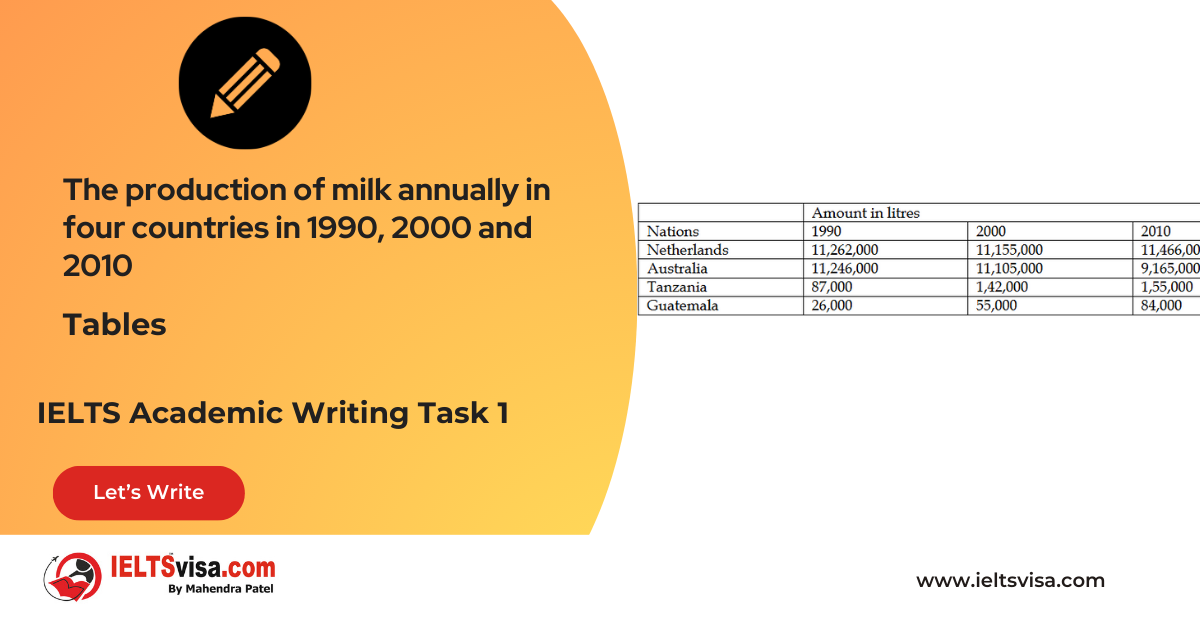
IELTS Writing Task 1 Question
The table below shows the production of milk annually in four countries in 1990, 2000 and 2010. Summarise the information by selecting and reporting the man features and make comparisons where relevant.

Common Questions for Data Summary
1. Diagram Type: Table.
2. Title: Annual Milk Production in Four Countries (1990, 2000, 2010).
3. What is being described?: The annual production of milk in four countries over three decades.
4. Where is this process happening?: In the Netherlands, Australia, Guatemala, and Tanzania.
5. What is the data about?: A comparison of the milk production of these countries in 1990, 2000, and 2010.
6. Topic: The change in milk production over time in four countries.
Comparison Showing and Trends Any change over time (such as an increase or a decrease) is a trend.
Details:
- Netherlands: The leading producer, though production fell slightly from 1990 to 2000, it increased again by 2010.
- Australia: A decline in milk production, with a gradual decrease from 11,246,000 litres in 1990 to 9,165,000 litres in 2010.
- Tanzania & Guatemala: Both countries saw significant growth in milk production, especially Guatemala, which more than doubled its production from 1990 to 2000.
- Guatemala: The country with the smallest production, yet it experienced the largest percentage increase.
Sample Answer
The table shows the annual production of milk in four countries—Netherlands, Australia, Guatemala, and Tanzania—over three decades.
Overall, while it is clear that the Netherlands consistently led milk production and experienced an increase in milk production over the 20-year period, Australia saw a decline.
In 1990, the Netherlands produced 11,262,000 litres of milk, and this figure decreased slightly to 11,155,000 litres in 2000 before rising again to 11,466,900 litres by 2010. Australia closely followed the Netherlands in 1990 with 11,246,000 litres, but production declined gradually over the following two decades, reaching 9,165,000 litres in 2010.
Tanzania and Guatemala showed significant growth in their milk production. Tanzania’s production grew from 87,000 litres in 1990 to 155,000 in 2010. Though producing the least milk overall, Guatemala saw the largest proportional increase, from 26,000 litres in 1990 to 84,000 litres in 2010.
In 1980, Japan produced only 0.6 million tonnes of waste, the lowest among the six countries. The USA, by contrast, generated 141 million tonnes of waste, which was the highest. Over the next decade, waste production increased sharply in Ireland, from 20 million tonnes to 41 million tonnes, and in the USA, from 141 million tonnes to 213 million tonnes. Waste generation in Portugal and Poland grew slightly, while Korea’s data was missing in 1990.
Between 1990 and 2000, waste generation increased moderately in Ireland, Portugal, and the USA, but Korea’s waste production decreased from 31 million tonnes in 1990 to 19 million tonnes in 2000.
Top 27 Vocabulary
| Vocabulary | Meaning | Synonyms | Examples | Type |
| Proportionate | In relation to a part of a whole | Relative, comparative | “Guatemala showed the largest proportionate increase in milk production.” | Adjective |
| Fluctuated | To change or vary irregularly | Vary, oscillate | “The production in the Netherlands fluctuated slightly between 1990 and 2000.” | Verb |
| Declined | To decrease in number or quality | Decreased, dropped | “Milk production in Australia declined over the years.” | Verb |
| Significant | Important or notable in size | Considerable, substantial | “Tanzania saw a significant increase in milk production.” | Adjective |
| Overall | In general, considering everything | Generally, in total | “Overall, the milk production increased in all countries except Australia.” | Adjective |
|
Consumption |
The act of using up a resource |
Usage, utilization |
“The consumption of milk varies across different countries.” |
Noun |
|
Yield |
The amount produced of a product |
Output, production |
“The milk yield in Australia has decreased over time.” |
Noun |
|
Consistently |
In a steady and reliable manner |
Steadily, regularly |
“The Netherlands consistently led in milk production.” |
Adverb |
|
Moderate |
Neither too high nor too low |
Average, reasonable |
“The Netherlands showed a moderate increase in production.” |
Adjective |
|
Gradually |
Occurring in small stages over time |
Slowly, progressively |
“Australia’s milk production gradually declined.” |
Adverb |
|
Outpace |
To move faster or do better than |
Surpass, exceed |
“Tanzania’s growth rate in milk production outpaced others.” |
Verb |
|
Expansion |
The act of increasing in size or scope |
Growth, enlargement |
“Guatemala experienced a rapid expansion in milk production.” |
Noun |
|
Marginal |
Small or insignificant in amount |
Slight, minimal |
“There was only a marginal drop in the Netherlands’ output.” |
Adjective |
|
Dominate |
To be the most significant or powerful |
Lead, control |
“The Netherlands continues to dominate the dairy industry.” |
Verb |
|
Escalation |
A rapid increase in amount |
Surge, rise |
“Guatemala saw an escalation in milk production levels.” |
Noun |
|
Dwindle |
To shrink or reduce gradually |
Decrease, diminish |
“Milk production in Australia continued to dwindle.” |
Verb |
|
Stabilize |
To become steady or unchanging |
Maintain, steady |
“Production in the Netherlands stabilized after a brief dip.” |
Verb |
|
Noteworthy |
Deserving attention due to importance |
Remarkable, significant |
“The increase in Tanzania’s milk production is noteworthy.” |
Adjective |
|
Projection |
An estimate or forecast based on trends |
Prediction, forecast |
“Future projections suggest further growth in Tanzania.” |
Noun |
|
Considerable |
Large in size or amount |
Substantial, significant |
“There was a considerable difference in milk production levels.” |
Adjective |
|
Surge |
A sudden and large increase |
Rise, jump |
“Guatemala witnessed a surge in milk production.” |
Noun |
|
Decline |
A continuous decrease over time |
Drop, reduction |
“Australia’s milk production faced a steady decline.” |
Noun/Verb |
|
Surpass |
To exceed or go beyond |
Outdo, exceed |
“Tanzania’s milk production may soon surpass expectations.” |
Verb |
|
Trend |
A general direction of change |
Pattern, tendency |
“The trend indicates increasing milk production in Tanzania.” |
Noun |
|
Peak |
The highest level reached |
Maximum, summit |
“Milk production in the Netherlands peaked in 2010.” |
Noun/Verb |
|
Dip |
A slight or temporary drop |
Decline, drop |
“There was a dip in the Netherlands’ milk output in 2000.” |
Noun |
|
Sustained |
Continuing for a long period |
Continuous, ongoing |
“Guatemala saw sustained growth in milk production.” |
Adjective |

Our Books
Master IELTS Speaking Part 1
IELTS Writing Task 1 Book
IELTS Writing Task 2 Book
Writing Task 1 Question Types
Practice IELTS Other Modules
IELTS Listening
The IELTS Listening test assesses how well you can understand spoken English in various contexts. It lasts about 30 minutes and is divided into four sections with a total of 40 questions. The listening tasks become increasingly difficult as the test progresses.
IELTS Academic Reading
The IELTS Academic Reading section assesses your ability to understand and interpret a variety of texts in academic settings. It is designed to evaluate a range of reading skills, including skimming for gist, reading for main ideas, reading for detail, understanding inferences, and recognizing a writer's opinions and arguments.
IELTS Speaking
The IELTS Speaking test assesses your ability to communicate in English on everyday topics. It lasts 11-14 minutes and consists of three parts: introduction, cue card, and a discussion based on the cue card topic.
IELTS General Reading
IELTS General Reading tests your ability to understand and interpret various types of texts. Here are some key areas and types of content you can expect to encounter in the reading section, along with tips for effective preparation.
IELTS Academic Writing Task 1
In IELTS Academic Writing Task 1, you are presented with a visual representation of information, such as graphs, charts, tables, or diagrams, and you are required to summarize, compare, or explain the data in your own words.
IELTS General Writing Task 1
In IELTS General Writing Task 1, you are required to write a letter based on a given situation. The letter can be formal, semi-formal, or informal, depending on the prompt. Here’s a breakdown of the key components to include in your letter
IELTS Academic Writing Task 2
In IELTS Academic Writing Task 2, you are required to write an essay in response to a question or topic. Here’s a guide to help you understand the essential elements of this task
IELTS Exam Tips
To succeed in the IELTS exam, practice regularly, familiarize yourself with the test format, improve your vocabulary, develop time management skills, and take mock tests to build confidence.
Grammer for IELTS
Grammar is the foundation of effective communication in English. Understanding tense usage, subject-verb agreement, and sentence structure enhances clarity and coherence in writing and speaking.
Vocabulary for IELTS
Vocabulary plays a crucial role in the IELTS (International English Language Testing System) exam, especially in the Speaking and Writing sections. Here’s an overview of why vocabulary is important and how it impacts your performance
RECENT IELTS SAMPLES QUESTIONS AND ANSWERS
Task 1 – Column graph – Percentage of Young People Enrolled in Universities in 2000 and 2007.
20:00 Start Pause Stop [df_adh_heading title_infix="IELTS Writing Task 1 Question" use_divider="on"...
Task 1 – Bar Graph – Annual Teaching Hours by Teachers in Different Countries (2001)
20:00 Start Pause Stop [df_adh_heading title_infix="IELTS Writing Task 1 Question" use_divider="on"...
Task 1 – Pie Charts – Coffee Production, Consumption, and Profit Distribution Worldwide
20:00 Start Pause Stop [df_adh_heading title_infix="IELTS Writing Task 1 Question" use_divider="on"...
Task 1 – Column graph – Types of Transport Used by Tourists Visiting New Zealand from Five Countries in 2004.
20:00 Start Pause Stop [df_adh_heading title_infix="IELTS Writing Task 1 Question" use_divider="on"...
Task 1 – Bar and Pie Chart Combination – Employment Types in 1998 and 2001
20:00 Start Pause Stop [df_adh_heading title_infix="IELTS Writing Task 1 Question" use_divider="on"...
Task 1 – Diagram – Comparison of Stone Tool Development Over Time
20:00 Start Pause Stop [df_adh_heading title_infix="IELTS Writing Task 1 Question" use_divider="on"...

